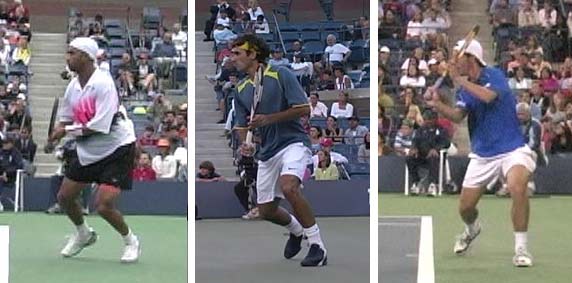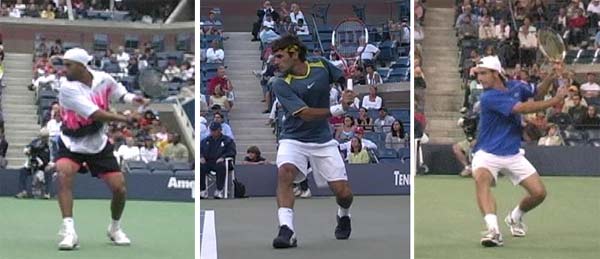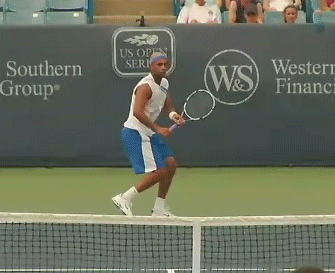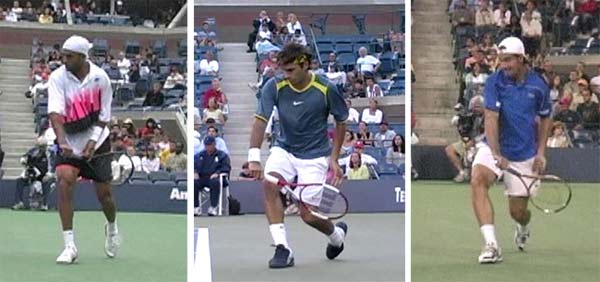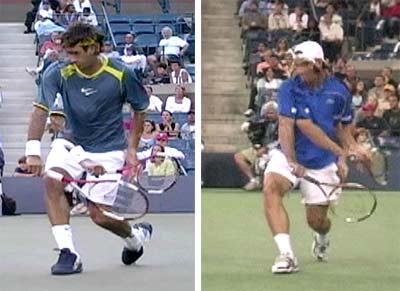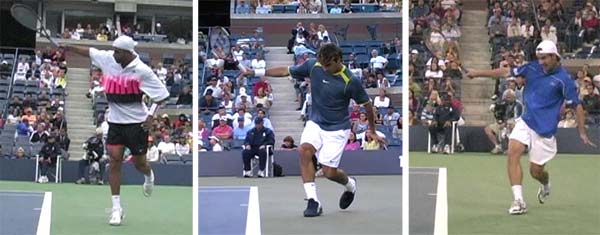|
TennisOne Lessons Comparative Analysis of the One-Handed Backhand:
Doug Eng EdD, PhD
Although the two-handed backhand is more prevalent in pro tennis, many believe that a world-class one-handed backhand is the most elegant stroke in the game. Many of the all-time greats, and even recent greats (such as Sampras, Federer, and Henin) have terrific one-handed backhands. Let’s examine three of today’s most potent backhands: those of James Blake, Roger Federer and Richard Gasquet. In this case study, let’s look at both commonalities and differences among these three great players. In general, they strike differently but have certain fundamental commonalities. Blake prefers to hit hard and flat through the ball. He dictates play with an extremely aggressive backhand. Blake often stands close to the baseline and attacks with pace. On the other hand, Gasquet hits a heavily spun ball but with pace and angles. Gasquet will often stand well behind the baseline and yet be amazingly effective. Last, Federer mixes up his backhand and plays more slice than most touring pros. He has the ability to play almost anything off his backhand and has a wonderful drop shot and a short angled slice that pulls opponents off the court. The Pivot and Unit Turn
Above, we see all three pros (James Blake, Roger Federer, and Richard Gasquet) turn the left foot parallel to the baseline and transfer weight to the foot. We can see the beginning of a stylistic difference between Gasquet and the others as Richard already brings his racquet high above his shoulders. You can also see that his grip is slightly different from the others as he uses a western (aka strong eastern) backhand grip. This grip allows a more naturally closed racquet face and a higher point of contact. He raises both hands high which allow greater rotation in his shoulders and backswing. On the other hand, Blake and Federer keep their racquet hands at waist level indicating a lower backswing. They also have not yet shifted their weight to the back foot. That indicates less reliance on rotation and more on linear weight transfer as we will see soon. Top of the Backswing
All of our players set their feet similarly in slightly closed stances with the weight on their right (front) foot. But that is where the commonality ends. Note Gasquet’s high backswing as a result of his high hands in the unit turn. If you play golf, you might make the analogy of Gasquet to Tiger Woods’s modern backswing which relies on the separation angle between the shoulder and hips rather than the old-fashion “step into the ball” leg drive. Gasquet creates large shoulder turn as his high backswing allows his right elbow to pull farther back even with his left shoulder. Note the right elbow of Gasquet is well behind his head. Gasquet’s grip and high backswing allow him to hit heavy topspin even on shoulder-high balls.
On the other hand, Blake and Federer both set their hands lower and use less shoulder-hip angle. Instead, they will slide their weight and legs more effectively into the direction of ball’s path. I recommend trying Gasquet’s backswing if you want more power and spin. It is a longer backswing and you may be less consistent with it but if you can master this backswing, it could improve your backhand. If you have consistency problems, you may want to copy Blake. He sets his racquet the lowest. His relatively low backswing will result in the simplest backswing and the flattest swing of the three. He will produce a simpler, linear path through the ball. Federer takes his swing almost as high as Gasquet but the extension of his arm backwards is not as extreme as Gasquet. In comparison, Blake and Federer set their elbow just pass the left ear which sufficiently turns the shoulder. The right elbow of Blake and Gasquet are slightly bent (about 20 degrees from perfectly straight whereas Federer’s arm is bent at about 60 degrees. All players do raise the racquet straight up from perpendicular to the ground (Federer, Gasquet) to about 75 degrees from parallel (Blake). Release and Bottom of the Swing
The release point is when your left hand lets go of the racquet. It is rarely discussed but remains an important checkpoint in the one-handed backhand. If you have a one-hander, you might have been taught to cradle the racquet on the backswing and then release on the forward swing. Then you were taught to spread your arms like wings or like a baseball umpire signaling safe(!). But at what point do you let go?
I personally like to teach that the left (non-dominant hand) cradles the racquet until this hand reaches the outer left hip. When you stand, your hands are neutral at your side in a natural position. You want to be natural so in the backhand, when your hand reaches the neutral position again, it is natural to release. Many players with two-handed backhands have a one-handed slice. When playing a one-handed slice as a two-hander, players either a) best release at the hip or b) hold the racquet with both hands a bit longer and release slightly past the left hip. The motion in case b) adds racquet head stability and linear momentum. After the release and contact point, you often see both hands go forward separately. James Blake actually does a bit of case b) and holds on the racquet past the outer left hip. Because he holds the racquet longer with his left hand, his release point coincides with the lowest point of his forward swing. Blake’s swing is also the flattest so the racquet head never really drops after his release. On the other hand, Federer and Gasquet hit with more spin. They both release the racquet when their left hand reaches the hip. Look at strobe photos of Federer and Gasquet below. (I don’t show this strobe effect with Blake since the release and lowest part of the swing coincide).
After Federer or Gasquet release the racquet, the racquet head drops down so that the top edge of the frame is about an inch or two below the right hand. Many club players don’t let the racquet head drop as they are too tense in the hitting arm. You can see that Federer and Gasquet are fairly relaxed as they let the racquet head drop after the release before beginning the upwards swing. If you have trouble doing this and hit too flat or with slice, try thinking that the racquet is heavy and your hand is relaxed. So when you let go with the left hand, you naturally allow the racquet to drop down. Contact Point
There are two major commonalities among all good one-handed backhands. And the first one you can see in the photos above. All three pros make contact well in front of the body when the arm straightens. Also, we noted that in the backswing, the players all have different arm and elbow positions, but here, all elbows are straight. The straight arm is the most stable position for the racquet head at contact which is perpendicular to the ground. Note Blake’s left hand continues to go slightly forward whereas Federer’s goes back slightly. Gasquet’s hand remains at his side in a neutral position. Note also that because Gasquet initially shifted his weight to the back foot, his weight still is slightly backwards as opposed to Blake’s more forward weight transfer. Ideally, you may want to achieve Blake’s or Federer’s position which is more balanced and therefore could result in a more consistent striking of the ball. Full Extension After Contact
The second major commonality among touring pros is the full extension after contact. You might say that from the release of the left hand to the full extension, the racquet clearly drives through the ball. Many club players try to hit excessive topspin by lifting the racquet on a shorter, more vertical plane. Here we see the plane is not as vertical as we think but rather long. All arms remain straight after contact and the racquet reaches full extension when the hand reaches shoulder-height (which makes sense, anatomically). The straight, extended arm is critical to hitting through the ball. Some coaches may argue that as part of the follow-through, it doesn’t matter as much since the ball already left the racquet. However, it is important to note that the arm extension is the desired consequence of hitting through the ball. In addition, all players remain sideways to the camera. Often we see players open their shoulders and hips up, but this does not occur until later. The sideways position and excellent arm extension shows the intent of the players to drive through the ball. If the player opens up, the racquet will slide off the path of the ball and impart side spin or not strike the ball cleanly. Although there are some differences such as in the head position, footwork or the left arm at this point, I think the major point here is the amount of linear momentum retained after contact which shows the intent of each player to drive through the ball. You can practice this by swinging slowly in your warm-up feeling your racquet continuing towards the target and your arm extending outwards. Pretend to hit two balls (or have two points of contact) about 18” apart. That makes you drive through the ball. Full Rotation on the Follow-Through
This photo is a bit of a surprise since you might expect that since Gasquet hits the heaviest spin and produces the most rotation in the backswing, he might have the most body rotation in the follow-through. Not quite. Blake actually rotates the most here and also gets the greatest weight transfer. Federer is fairly neutral in his stance but you can see his back and shoulder flexibility as his racquet arm goes well behind. Gasquet possesses shortest finish but keep in mind that he produces his spin from his grip and shoulder turn in the backswing. Federer and Blake are hitting flatter and therefore generate more translational (in the direction of the ball path) racquet head speed through the ball. Gasquet is hitting more up so not only does his swing shorten but his weight goes back slightly. His head is over his back foot. Gasquet already produced much rotation and racquet head speed with the full backswing. Any topspin drive relies on a low-to-high swing so Gasquet is not exactly rotating through but finishing high. Blake’s short backswing and acceleration result in the most rotation on the finish. He cannot slow down the momentum gained so he will tend to follow through the most. Conclusions In this article, our three pros have both common and different elements in their backhands. The strongest commonalities came in the actual ball striking phase and immediately after. The differences mostly occurred in the backswing preparation and finish of the swing. There was also the often overlooked difference in the release of the racquet. Regardless of ability, no tennis player can violate physics and fundamental contact with the ball. It matters far less what happens before the contact and well after. The contact point and hitting through the ball are the most fundamental parts of your swing. Less important are the backswing and finish where stylistic variations exist. However, those parts we often like to copy at the expense of the essential contact phase. To be successful, always keep in mind what is essential for success. Acknowledgments I would like to thank Bobby Bernstein at the USTA Player Development in Key Biscayne, Florida. The photos in this article were taken from his digital videos using Dartfish software. Your comments are welcome. Let us know what you think about Doug Eng's article by emailing us here at TennisOne.
Doug Eng EdD PhD coaches men's tennis at Tufts University. During the summer, he directs at the Tennis Camps at Harvard. He has received divisional Pro of the Year honors from the PTR and USPTA and several national award. Doug completed the USTA High Performance Coaches program and frequently runs educational and training programs for coaches. Doug also writes and speaks on tennis and sport science. |

